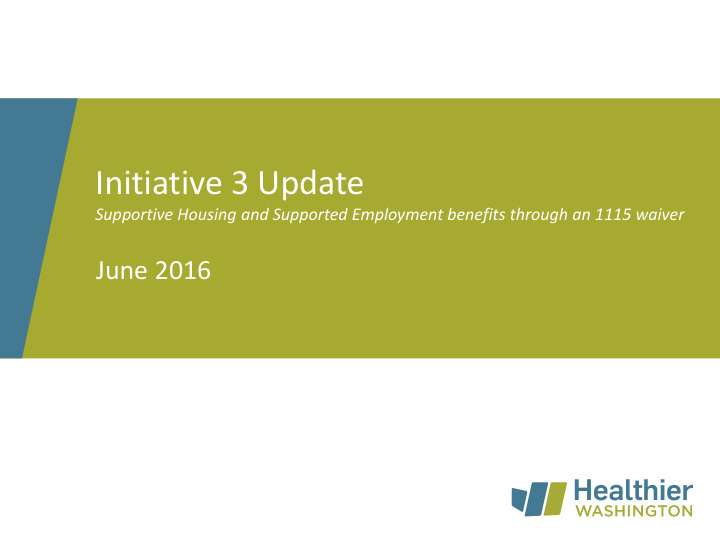



Initiative 3 Update Supportive Housing and Supported Employment benefits through an 1115 waiver June 2016
Waiver Initiatives Initiative 1 Initiative 2 Initiative 3 Transformation through Accountable Enable Older Adults to Stay at Home; Delay Targeted Foundational Communities of Health or Avoid the Need for More Intensive Care Community Supports Delivery System Benefit: Medicaid Benefit: Supportive Transformation Alternative Care (MAC) Housing • Each region, through its • Individualized, critical services and • Community-based option for Accountable Community of Health, Medicaid clients and their families. supports that will assist Medicaid will be able to pursue projects that • Services to support unpaid family clients to obtain and maintain will transform the Medicaid caregivers. housing. The housing-related delivery system to serve the whole services do not include Medicaid person and use resources more payment for room and board. wisely. Benefit: Tailored Supports • Also known as Delivery System for Older Adults (TSOA) Benefit: Supportive Reform Incentive Payments (DSRIP). Employment • For individuals “at risk” of future • Services such as individualized Medicaid LTSS not currently job coaching and training, meeting Medicaid financial employer relations, and eligibility criteria. assistance with job placement. • Primarily services to support unpaid family caregivers. Pay for Performance Projects Medicaid Benefits/Services
Initiative 3: Medicaid Funds Flow Medicaid HCA BHA ALTSA Purchaser Tribes MCOs BHOs HCS/AAAs Payer SH/SE – SH/SE – SH/SE – Physical Behavioral Tribal SH/SE - LTSS Provider Health Health Members Conditions Conditions 3
Initiative 3: Supportive Housing — Eligible Services • Housing transition services that provide direct support to help individuals obtain housing, including: – Housing assessment and development of a plan to address barriers. – Assistance with applications, community resources, and outreach to landlords. • Housing tenancy sustaining services that help individuals maintain their housing, including: – Education, training, coaching, resolving disputes, and advocacy. • Activities that help providers identify and secure housing resources. Supportive housing services do not include funds for room and board or the development of housing. 4
Populations most likely to benefit from supportive housing services • Chronically Homeless • Individuals with frequent or lengthy institutional contacts • Individuals with frequent or lengthy adult residential care stays • Individuals with frequent turnover of in-home caregivers • Those at highest risk for expensive care and negative outcomes — PRISM Risk Score of 1.5 or above 5
Initiative 3: Supported Employment Individual Placement and Support (IPS) Model • An evidence-based approach to supported employment for individuals with significant barriers to employment – 23 randomized controlled trials (Dartmouth, 2015) • Principles of Supported Employment: ‒ Open to anyone who wants to work ‒ Focus on competitive employment – Rapid job search – Systematic job development – Client preferences guide decisions – Individualized long-term supports – Integrated with treatment – Benefits counseling included 6
Populations most likely to benefit from supported employment services • Enrollees in Aged, Blind and Disabled (ABD) program or potential to enroll in Housing and Essential Needs (HEN) • Individuals with: – Severe & Persistent Mental Illness – Multiple episodes of Substance Use Treatment – Co-occurring Disorders • Youth in transition with behavioral health diagnosis An individual may be eligible for supported employment and supportive housing if he or she falls within eligible populations for both benefits and exhibits a medical/functional need for both. ALTSA: Supported employment services will be implemented concurrently for individuals eligible for long-term support services, including those with traumatic brain injuries (TBI). 7
Supportive Housing Proposed Phasing 1. Chronically Homeless (HUD Definition) ‒ BHO and FIMC ‒ Full BHO/MCO benefit 2. Frequent/Lengthy Institutional Contact 3. Frequent/Lengthy Adult Residential Care Stays 4. PRISM Score 1.5+ Why phasing? • Housing stock • Delivery system and provider capacity build • Assessment of demand 8
Proposed Supportive Housing & Supported Employment Criteria Medical Necessity Criteria – for MCO benefit • Inability to live in an independent or family setting without support • At risk of serious harm to self or others • Dysfunction in role performance • Risk of deterioration BHO benefit will still use Access to Care Standards. ALTSA benefit will use CARE criteria. 9
Other issues under consideration • Payment model • Encounter definition • Fidelity review • Provider credentialing/licensure
Where to find more information http://www.hca.wa.gov/hw/Pages/medicaid_transformation.aspx Resources available: • Draft Project Toolkit Framework • Updated FAQ and Fact Sheets • Waiver Application • Previous webinar presentations (slides & recordings) • Updates on workgroup activities Workgroups • Chronic Homelessness Policy Academy • Olmstead Policy Academy Send questions and comments to: Medicaidtransformation@hca.wa.gov 11
For more information, contact: Website: www.hca.wa.gov/hw Join the Healthier Washington Feedback Network: healthierwa@hca.wa.gov For questions about Medicaid Transformation: medicaidtransformation@hca.wa.gov 12
Recommend
More recommend